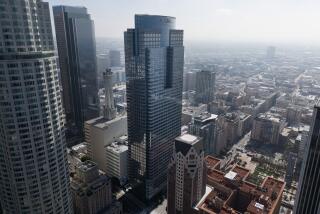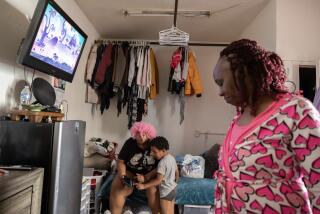Asbestos May Derail Plans for Building at Sears Site
Developers interested in buying the old Sears store in Hillcrest expressed severe reservations Thursday because the presence of asbestos in the cavernous, 34-year-old building may make its demolition prohibitively expensive.
The City of San Diego, which bought the 12-acre site that includes the 265,000-square-foot former department store, is so concerned about the developers’ misgivings--brought into the open in a meeting Thursday at City Hall--that it plans to hire a consultant to determine how much asbestos is in the building.
“That question (about asbestos) is such a serious one it will call into question the real underlying value” of the site, said Barry McComic, the head of R.B. McComic Inc., and one of the builders who attended the meeting.
The presence of asbestos could delay the bidding process on the site because some developers are unlikely to risk a bid without knowing the extent of the problem.
Could Threaten Plans
If the presence of asbestos is widespread, thus making its removal difficult, time-consuming and costly, it would threaten the city’s plans to recoup its $10-million investment in the site by selling it for a mix of retail and residential development.
Asbestos was widely used in the 1950s as a material for insulation and fireproofing. It is a known carcinogen and is the cause of a lung disease called asbestosis.
The City Council bought the old store on Cleveland Avenue in 1986 at the urging of Councilman Bill Cleator, who wanted to turn the site into a new central library. But the City Council later rejected that idea and instead has moved to sell it, but only for a minimum of $9.5 million.
On Nov. 24, the city issued its guidelines to developers, seeking “requests for proposals.” Those guidelines included a three-sentence notice telling bidders, as required by state law, that the old department store was built using asbestos as a fireproofing material, a common construction technique in those days.
Dominated Discussion
Questions about asbestos dominated Thursday’s meeting to discuss the guidelines with city officials, including representatives from the Planning and Property departments, according to several developers who attended.
There were, however, more questions than answers. No one knows how much asbestos is in the building or how much it will cost to remove it as part of the demolition.
The city has estimated it will cost $2.2 million to demolish the old store, but, according to developers, that doesn’t take into account removal of asbestos.
“Obviously you have to deduct from the value what it costs not only to remove the asbestos . . . but how long it’s going to take you to get respective approvals from” government health agencies responsible for overseeing the removal of asbestos, McComic said.
“Timing is extremely important in a deal like this,” said McComic, noting that few developers would be willing or financially capable to wait for a long time for approvals from regulatory agencies.
There is also only one licensed hazardous waste dump in California, situated in Santa Barbara, that accepts asbestos, and there’s no guarantee it would accept the material. Some of the developers estimated it may cost as much as $15,000 a truckload to haul the asbestos from the old Sears store to the Santa Barbara dump.
The city wants the developers to submit their bids by Jan. 4, which the builders say is unrealistic because they won’t have time in the next month to adequately evaluate the asbestos problem, and its ramifications, and still make an intelligent bid.
“Right now it’s a buyer-beware situation,” said Ted Odmark, head of The Odmark Development Co., who also attended the briefing. Odmark said city officials at the meeting made it clear that developers would have to deal with the asbestos problem. “I don’t think anybody knows what’s there right now,” Odmark said.
Removal Called Costly
Removal of asbestos is very costly, he said, noting that he is currently involved in a construction project out of state in which asbestos is a problem.
The developers also said the city warned them that a transformer in the building may be contaminated with toxic PCBs, though that hasn’t been confirmed.
Regardless, the builders said they left the 2 p.m. City Hall briefing with the clear understanding that they and not the city would be responsible for determining the extent of any contamination and providing for its removal.
But the city now may take steps to determine the extent of the problem.
Herb Lemmons, a project administrator in the Property Department’s economic development division who took part in the briefing, said the city intends to hire a consultant to examine the former store for asbestos.
“We don’t know what’s involved with asbestos,” he said. What the city does know is that asbestos was apparently used around a boiler and water coolers. If that’s the extent of asbestos in the structure, its removal wouldn’t seriously hinder its demolition, according to developers.
Lemmons said has begun the paper work needed to hire a consultant, which the city hopes to do in the next week or so.
The city was unaware of a potential asbestos problem, Lemmons said, until a Nov. 16 City Council meeting, when a developer brought up the issue. At the time, Councilman Cleator asked James Spotts, the city’s property director, to investigate whether the city can take legal action against Sears, which Cleator said sold the building without revealing the presence of asbestos or that the structure is built on uncompacted fill. Both problems, Spotts acknowledged at the time, have increased demolition costs.
Not Told Status
Spotts was unavailable for comment Thursday, as was Cleator. Pat Barnes, a Cleator aide, said that so far the city administration has not told the councilman the status of the investigation.
Tess Wilcoxson, chairwoman of the Uptown Planners group, which advises the council on land-use matters in the Hillcrest area, said that throughout the lengthy discussions before and after the City Council’s purchase of the Sears site, the issue of asbestos was never raised. That’s because, she said, “is wasn’t really clear the city knew the building had an asbestos problem.”
“In retrospect, it’s ludicrous that it wasn’t discussed . . . its removal could most more than $1 million,” Wilcoxson said.
McComic, told that the city intends to examine the building for asbestos, said the city really has no alternative if it “intends to maximize the value of the site.” Without such a review, he said, the situation “would overwhelm most mortal developers.”
More to Read
Sign up for Essential California
The most important California stories and recommendations in your inbox every morning.
You may occasionally receive promotional content from the Los Angeles Times.






